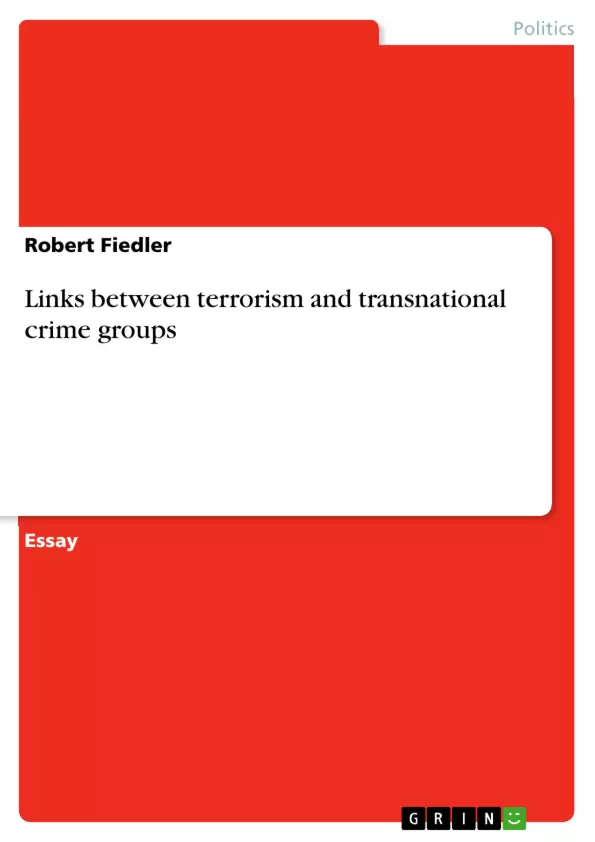Given today’s existence of hundreds of terrorist groups and thousands of criminal ones (Schmid, 2005) it is not surprisingly that in “some cases a symbiosis between terrorism and organised crime occurred that did not exist before” (Laqueur, 1999, p. 211). In fact, since the early 1990’s “Western law enforcement agencies have noted an increased reliance on criminal activities by terrorist groups” (Mili, 2006, p. 8) a relationship that seems only natural given that terrorism itself is always a crime (Gorka, 2000). Hence, it is assumed that there is a “close connection between international terrorism and transnational organized crime” (United Nations Security Council, 2001). Some even argue that both criminal activities “bleed into one another” (Makarenko, 2003) and that there is a “possibly irreversible trend towards a convergence of these activities” (Williams & Sanova, 1995, p. 28).
In the following this paper will argue that the linkages between criminal and terrorist activities have increased since the end of Cold War in the early 1990’s. However, the structure of these linkages is contested in the scholarly debate. In order to find a conclusion, this paper will analyze major changes in the structure of terrorist and criminal groups. In a second section the prevailing scenarios of a terrorist-criminal nexus will be outlined and critically discussed.
Inhaltsverzeichnis (Table of Contents)
- Links between terrorism and transnational crime groups
- The changing role of state sponsorship
- Globalization processes and the nexus between terrorism and criminality
- Network structures and the advantages for terrorist and criminal organizations
- Similarities between terrorist and criminal groups
- The nexus between terrorists and criminality: A scholarly debate
- Alliances for mutual benefits
- The limited scope of cooperation
- Trust, ideology, and the difficulty of forging long-term alliances
Zielsetzung und Themenschwerpunkte (Objectives and Key Themes)
The primary objective of this paper is to analyze the increasing linkages between criminal and terrorist activities since the end of the Cold War. The paper aims to explore the structure of these linkages and critically discuss the different scenarios of a terrorist-criminal nexus.
- The declining role of state sponsorship in terrorist activities and the rise of criminal activities as a source of funding for terrorist groups.
- The impact of globalization processes on the interaction and cooperation between terrorist and criminal organizations.
- The advantages of network structures for both criminal and terrorist organizations in terms of security, flexibility, and expansion.
- The striking similarities between terrorist and criminal groups in terms of organizational structure, funding strategies, and operational tactics.
- The complex and contested nature of the nexus between terrorists and criminality, examining different perspectives on the extent and shape of their relationship.
Zusammenfassung der Kapitel (Chapter Summaries)
This section focuses on summarizing the main themes, arguments, or narrative elements of each chapter without revealing major conclusions or spoilers.
- Chapter 1: This chapter explores the changing landscape of terrorist financing, highlighting the decline of state sponsorship and the increasing reliance of terrorist groups on criminal activities for funding.
- Chapter 2: This chapter examines the role of globalization processes in fostering the nexus between terrorism and criminality. It analyzes how globalization has facilitated the interaction and cooperation between these transnational groups.
- Chapter 3: This chapter delves into the network structures employed by both terrorist and criminal organizations. It discusses the advantages of network structures in terms of security, flexibility, and operational efficiency.
- Chapter 4: This chapter explores the striking similarities between terrorist and criminal groups, highlighting their shared organizational structure, funding strategies, and reliance on secrecy and trust.
- Chapter 5: This chapter examines the scholarly debate on the nature and extent of the nexus between terrorists and criminality. It presents different perspectives on the relationship, ranging from alliances for mutual benefit to the difficulty of forging long-term cooperation.
Schlüsselwörter (Keywords)
The main keywords and focus topics of this paper include: terrorism, transnational organized crime, state sponsorship, globalization, network structures, alliances, cooperation, trust, ideology, funding, and operational tactics. This paper examines the complex relationship between these key concepts and the factors that contribute to the increasing nexus between terrorist and criminal activities.
- Arbeit zitieren
- MSc. M.A. Robert Fiedler (Autor:in), 2008, Links between terrorism and transnational crime groups, München, GRIN Verlag, https://www.grin.com/document/163706



